Basics of Coordinate Metrology | Digression |
| around 7000 BC | Definition of a foot from about 7000 BC 1 foot corresponds to the length of a foot from the big toe to the heel. | 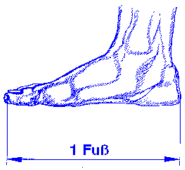 Definition of a foot (about 7000 BC) |
| around 4000 BC | In Egypt and Chaldea, the basic measure for measuring length is the royal yardstick. | |
| around 3000 BC | In Chaldea the units for determining length, volume, mass and time are related to one another. The basis of the measurement was a cube with an edge length of 1 foot. The edge length corresponded to a unit of length. The water to fill the cube gave the unit for mass and volume. The time for the water to drain from the cube (water clock) gave a unit of time. | |
| 2100 BC | On the statue of Gudea, the Prince of Sumer, the unit of length of 1 foot is subdivided into 16 finger's breadths. |  Old Egyptian scale (about 3000 BC) |
| 2000 BC | On a copper bar (the "Yardstick of Nippur") with a length of 1103.5 mm, a few linear measures have been marked: a yardstick, tile, foot, hand and finger's breadth. The 1103.5 mm are divided into 4 feet = 16 hands = 64 finger's breadth. | |
| 2000 BC
| The Greek adopt the schoinos (unit of length: ~ 6.3 km) from the Egyptians who had adopted it from the Persians. | |
| around 25 BC
| A book on architecture describes a device for measuring distances which worked like a simple mileage indicator. | |
| 807 AC | A uniform measurement and weight system is introduced in the empire of Charlemagne. | |
| 1101 | The yard is established in Henry's II England as the length of his arm from the shoulder to the tip of his middle finger. |  Yard - Definition under Henry II |
| 1215 | A uniform measurement and weight system is established in England, which, however, did not get accepted. | |
| 1324 | The inch is established in England as the length of three barley grains taken from the center of an ear. | |
| 1494 | King Henry VII tries to push through a measurement and weight system binding for entire England. | |
| 1588 | In England legally binding standard measures and weights are produced. Their copies are distributed among the calibration officers. |  Determination of the "yardstick" around 1595 1 yardstick = placing the left foot of the first 16 persons coming out of church on a particular Sunday next to each other |
| 1627 | In Ulm Johannes Kepler wants an oak tank to be produced which defines the measures valid in the city. | |
| 1722 | In the Electorate of the Saxony, milestones are erected which indicate distances. | |
| 1791 | According to the proposal by Pierre-Simon Laplace, the "metre" is defined as the ten-millionth part of the earth's meridian quadrant. | 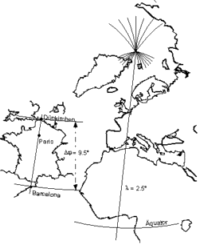 1 meter = forty-millionth part of the meridian of the earth on the Paris meridian |
| 1795 | The French National Convent decides that the "metre" is the forty-millionth part of the meridian of the earth going through the Observatory of Paris. | |
| 1799 | The prototype of the meter is produced in the form of a platinum rod. | |
| 1824 | In England the yard is defined as 0.9143834 m. | 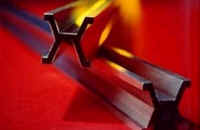 Prototype of the meter in the form of a platinum rod |
| 1829 | Henry Madslay constructs the micrometer screw which can be used to measure to the nearest 1/1000 of an inch. | |
| 1830 | In Saxony the local length measure "Lachter" is defined as 2 m. | |
| 1831 | Carl Friedrich Gauß suggests the absolute System of Units including the units millimeter, meter, milligram and second. | |
| 1840 | "metre" and "kilogramme" are established as legally binding units of measure for length and weight. | 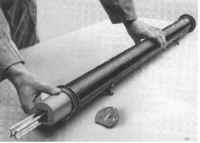 Prototyp "M" of the German standard meter |
| 1860 | The upper house of the German Parliament suggests the creation of a uniform measurement system. | |
| 1868 | The "Decree on weights and measures" of the North German Federation makes the metric system compulsory for wide parts of Germany. | |
| 1871 | The "Decree on weights and measures" of the North German Federation gains acceptance in the whole of Germany due to laws issued by the German Empire. | |
| 1875 | An international office for measurements and weights (BPIM) is established. | 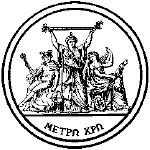 Bureau International des Poids et Mesures |
| 1889 | The prototypes for the meter and kilogram are established by the BIPM. | |
| 1918 | The USSR introduces the metric system. | |
| 1960 | The 11th General Conference for Measurements and Weights ratifies the "International System of Units (SI)". It establishes six base units: meter, kilogram, second, Ampere, Kelvin and candela. The length of the meter is redefined (krypton - wavelength definition). | |
| 1983 | The meter is defined more precisely than previously as "the length traveled by light in a vacuum during (1/299,792,458)th" of a second. | |
| 1980-1985 | The conversion to SI units takes place in many areas of economy and research. | |
| 1985 | China decides to introduce the SI units by the year 1990. |